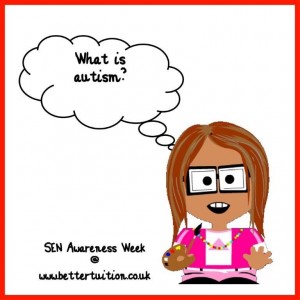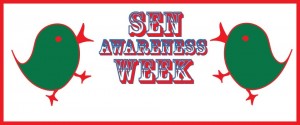Did you know that autism is just one of five main types of Autistic Spectrum Disorder? The autistic spectrum includes Asperger Syndrome, autism, Rett Syndrome, Childhood Disintegrative Disorder and Pervasive Developmental Disorder. Autistic Spectrum Disorders are not learning difficulties as such but are developmental disorders. Autistic Spectrum Disorder is present throughout the ability range – however it does represent a major barrier to accessing the curriculum.
Generally, the characteristics of Autistic Spectrum Disorders are difficulty in social communication, social relationships and imaginative thought. Those on the autistic spectrum can feel (and act) as though they live on a different planet from the rest of the world.
Early signs can be as diverse as avoiding eye contact, delayed speech and language development, getting upset by changes to routine and having unusually strong reactions to the way things look, sound, taste, feel or smell. These are all fairly commonplace in young children so it is important to realise that a child can display all of the above behaviours without having ASD. However, a parent’s instinct can be very strong – I recently came across this moving blog post about the mother of a child with Asperger Syndrome whose concerns were, frankly, fobbed off by professionals.
The autistic spectrum presents us with a rainbow of indicators, but whilst it’s useful to us to be aware of them, it’s important to remember you can’t and shouldn’t casually ‘diagnose’ autism in others (Asperger Syndrome, for example, has been described as ‘extreme male brain’).
Indicators of Autistic Spectrum Disorder include:
– difficulty and awkwardness in social situations;
– obsessive and compulsive behaviour and interests;
– lack of empathy;
– impaired use of language.
– a tendency to interpret language literally (If you tell someone with ASD to ‘pull your socks up’, they probably will.).
The symptoms of ASD can improve with time (although early childhood and adolescence are often very difficult periods), and social communicative norms such as eye contact can be learned, although they might never feel completely natural to someone with ASD, a bit like learning to parallel park.
It is sometimes said, rather thoughtlessly, that we are all ‘somewhere’ on the autistic spectrum. A quick google reveals there is an abundance of debate on the subject so the position is not at all clear-cut. I suppose you could argue we are all ‘a bit deaf’ or all ‘a bit blind’. The point I am making is that people make a lot of casual assumptions about ASD and often use it as a pejorative label for someone who lacks compassion, for example. Around one per cent of people worldwide (interesting explanation of the statistics relating to ASD here) have a diagnosis for ASD, so it’s neither widespread nor uncommon. If you or your child is affected by ASD, you may like to visit the website of the National Autistic Society for help, advice and information.
At Better Tuition, our qualified teachers can help your child (with or without ASD) learn, succeed and achieve their educational goals. Call Paul or Christine on 0161 748 3912 to book your FREE assessment in our Urmston tuition centre.



